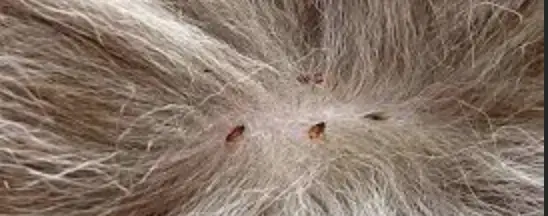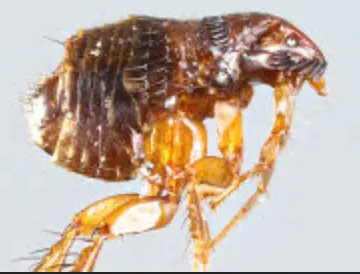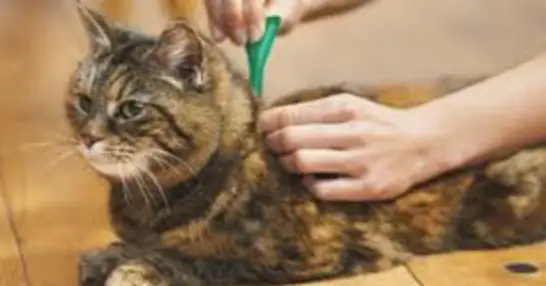Last Updated on 05/01/2025 by Kimberly
The cat flea, known scientifically as Ctenocephalides felis, is a small, wingless insect that thrives as an external parasite. Unlike other bugs, adult cat fleas are a reddish-brown hue and typically measure around 1 to 2 millimeters in length, making them quite difficult to spot on your feline friend’s fur.

Confusion often arises between cat fleas and dog fleas since both species target similar hosts and share many physical traits. However, cat fleas are more prevalent and not solely restricted to cats. They can infest dogs, rabbits, and other animals as well.
The lifecycle of a cat flea is both fascinating and formidable. They progress through four stages: egg, larva, pupa, and adult. Adult fleas can lay hundreds of eggs on their host, which then fall off and develop in the environment. This cycle can make tackling a flea infestation a daunting task as it requires addressing both the animal and its surroundings.
Recognizing cat fleas involves looking for tiny, dark specks in your pet’s fur—commonly referred to as flea dirt—and noticing persistent scratching or biting. Being proactive about checking your pets regularly can help you catch these pesky intruders early, facilitating easier management and control.
Can The Cat Flea Affect Humans?
Yes, cat fleas can bite humans too. While their primary hosts are usually furry animals like cats and dogs, humans can also fall prey to these tiny nibblers when there’s a severe infestation or if their usual hosts aren’t around.
The most common symptom of a flea bite in humans is an itchy red bump, often surrounded by a small halo. These bites are generally found on legs and ankles, where fleas can easily jump from pets. Besides being itchy and irritating, multiple bites can lead to discomfort and possible allergic reactions in some people.

Flea bites can pose health risks beyond just itching. In rare cases, fleas are carriers of certain diseases such as typhus or cat scratch disease, both of which can affect humans. The risk isn’t massive, but it’s wise to address a flea issue promptly to avoid any potential health problems.
There have been numerous documented cases where people experienced flea bites and subsequent allergic reactions. It’s important to keep an eye out for unusual symptoms following a bite, such as prolonged itching, swelling, or signs of an infection, and consult a medical professional if necessary.
Effective Prevention and Control of The Cat Flea
Preventing cat flea infestations involves a combination of good hygiene practices and effective products. Regular grooming and bathing of your pets are excellent first steps. Make it a habit to check your pet’s fur frequently, especially if they spend time outdoors. Using a flea comb can help you identify and remove any adult fleas or flea dirt.
Selecting the right flea control products can be overwhelming with so many options available. Treatments like topical solutions, oral medications, and flea collars can offer substantial protection. Brands such as Frontline, Advantage, and Seresto are well-regarded for their effectiveness. Always consult your veterinarian to choose the best option tailored to your pet’s needs.
Beyond treating your pets, it’s essential to tackle your home environment. Vacuum floors, carpets, and furniture regularly to capture eggs, larvae, and pupae. Washing your pet’s bedding in hot water at least once a week can also help eliminate any developing fleas. Consider using household sprays or foggers designed to kill fleas at various life stages, but always follow safety guidelines.
Maintaining a flea-free home involves ongoing commitment. Consistency is crucial, whether it’s keeping up with your pet’s flea treatments or maintaining a regular cleaning schedule. Outdoor areas where your pets play should also be treated if you notice any signs of fleas. By being vigilant and proactive, you can significantly reduce the chances of a flea infestation.
Comprehensive Care for Pets: Managing The Cat Flea
Recognizing the signs of a flea infestation early can make management much easier. Cats with fleas often exhibit excessive scratching, grooming, or biting at their skin, sometimes to the point of hair loss or skin irritation. Being attentive to these behavioral changes can alert you to the presence of fleas before they become unmanageable.
Regular grooming is crucial in preventing fleas. Brushing your cat with a flea comb can help catch adult fleas and remove flea dirt. Bathing your cat with a veterinarian-recommended flea shampoo can also help manage an existing infestation. However, some cats are resistant to baths, so other treatments like topical applications or oral medications might be necessary.
Veterinary guidance is invaluable when dealing with fleas. A vet can provide tailored recommendations for treatment based on your pet’s specific needs and health condition. Prescription options are often stronger and faster-acting than over-the-counter products, offering an effective solution without unnecessary trial and error.
Long-term strategies to protect your pets from fleas include keeping them on year-round prevention plans, especially if they frequently go outdoors. Consistent use of flea preventatives, along with maintaining a clean home environment, will offer the best defense. Seasonal changes can influence flea activity, so adjusting your approach as needed can help keep your pets flea-free year-round.
In Conclusion To What Are Cat Fleas?
I hope the information about cat fleas is helpful for you to better understand what they are capable of. If you don’t like to use chemical based products, I have a link below to all natural flea remedies that can give your kitty relief from fleas.
If you have any questions or information that you have learned about cat fleas, please share them below in the comments section. Sharing information and questions can help everyone better understand more about these pesky critters that attack our poor pets.
Thank you for visiting Fleas B Gone 🙂






